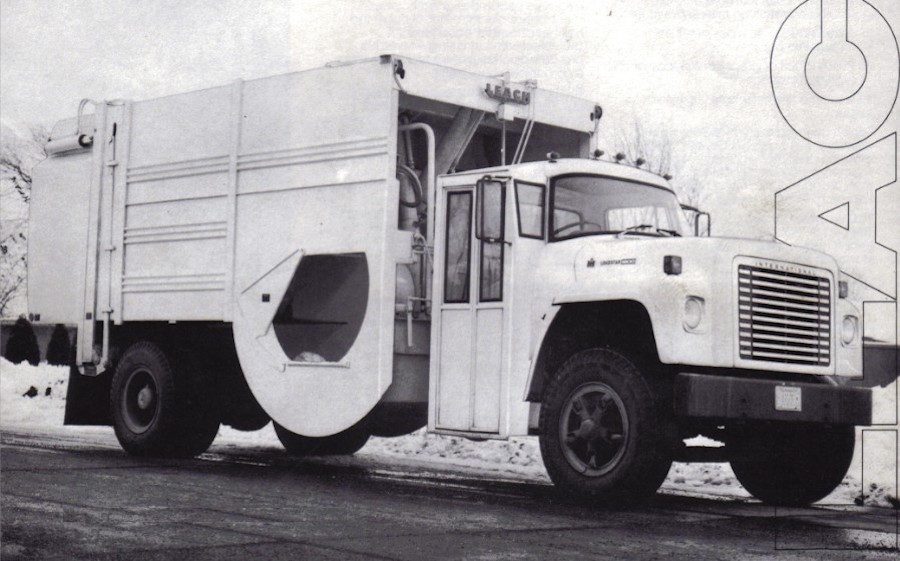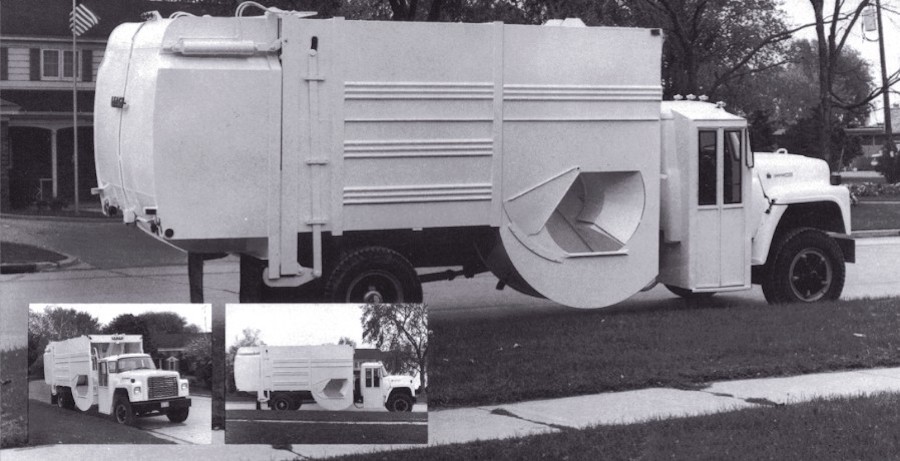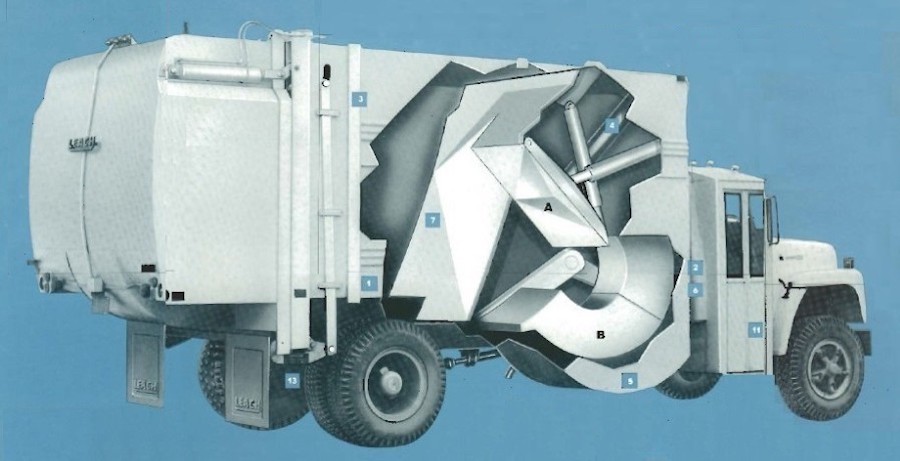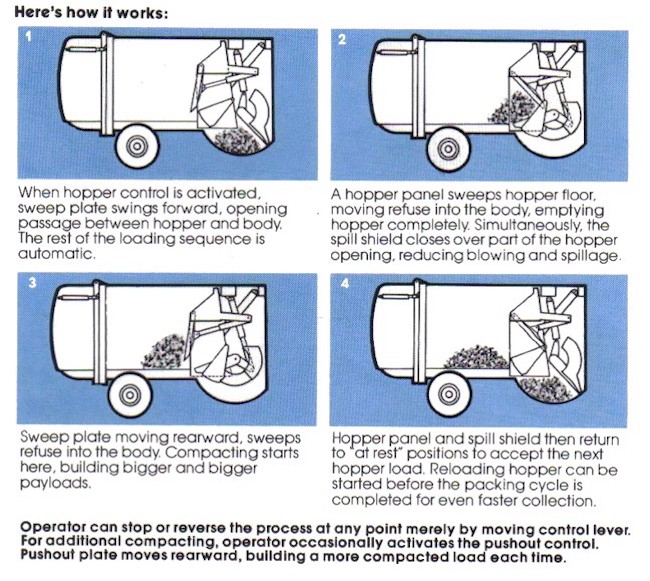 
Curbcruiser Side Loader

The low-loading, residential side loader concept had originally sprung up in southern California in the late 1950s. Though these bodies were available throughout most of North America by the mid-sixties, it remained mostly a western phenomenon, where Los Angeles-based rivals Bowles and Western competed for sales with their Load-n-Pack and Shu-Pak models, respectively.
Throughout the 1970s, the advantages of this type of body for one-man, manual residential collection were being realized on a broader national scale. McClain Industries introduced the OMSUL in 1973, and Maxon continued to pump out Shu-Paks after purchasing Western in 1970. The City of Scottsdale, Arizona, had even adapted a fully automated cart dumper to a Shu-Pak, which sported a custom-made full-eject body. Then in the late 1970s, The DSNY broke with four decades of rear loader tradition and made a large purchase of side loading Maxon Shu-Paks.
Against this backdrop, Leach Company threw their hat in the ring with the bold new Curbcruiser, which was announced in April of 1979. What makes this entry truly unique is that it achieved the low-loading height of a "drop-frame" side loader, without modification of a standard truck chassis. Drop-frame models are so called because the body builder or installer had to sever the frame rails of the truck chassis, and lower them significantly to accommodate the hopper of the packer body. This is not only expensive, but potentially weakens the chassis, which is already exposed to high amounts of stress in refuse collection duty.

This was overcome by Leach by simply limiting the hopper width to 28 inches, just enough to occupy the space between the outside right frame rail and the outer wall of the body. The hopper was "hung" in this dead-space which might normally house a fuel or oil tank, or storage rack on a conventional rear loader. A pendulum type packer blade was utilized to sweep the refuse into the body, and a full follower plate allowed for reloading while the blade was in operation.
At the end of the pendulum blade stroke, a secondary sweep panel then cleared the face of the blade, both packing and retaining the charge of refuse in the body. The result was a "clean sweep" with every cycle, eliminating the fallback commonly associated with side load packers. This is similar in concept to the Heil Colectomatic, only applied to a side loader. The Curbruiser also featured a full-eject body, using a single stage, double acting ejector cylinder.

As can be seen in the cutaway illustration, the sweeper panel is actually a hinged portion of the ejector panel, which (when extended) forms part of the ejector blade face, thereby achieving what the City of Scottsdale first proposed with their experimental Son of Godzilla automated container truck in 1972-73.* The ejector was also used to periodically consolidate the load already within the 20 cubic yard body, for even greater compaction ratios than would otherwise be possible with most other drop-frame side loaders.
To make things even easier at the dump, an automatic tailgate lock, powered by the end gate lift cylinders, kept the operator safely away from the rear of the truck during unloading.
The Curbcruiser was one of the many refuse trucks designs of Cyril Gollnick, Leach's chief engineer who had previously created the revolutionary Packmaster and 2R Packmaster rear loaders. The Curbcruiser was one of his last creations, and stands with the others as a testament to his ingenuity. But, alas, the Curbruiser was ultimately unsuccessful and was dropped after a very short production run.
Looking at the images here, it's a fair guess that the small sized hopper (one cubic yard capacity) was probably a sore point for most potential buyers. Measuring 46 x 32 inches, the restricted hopper opening left just enough room for one man to to empty a barrel, but not much else. Many bulky items simply would not fit, and modification for the addition of a cart dumper would seemingly be out of the question. The complexity of the packing mechanism and maintenance issues likely also weighed against the Curbruiser.
By comparison, conventional drop-frame side loaders had spacious, wide-open hoppers and could swallow a more varied menu of bulky items. What they may have lacked in compaction density could be made up in body weight savings, by merely offering a bigger box. Packer mechanisms and hydraulics were simple and mostly easily accessible. Additionally, other contemporary side loaders were easily adaptable to automated or semi-automated cart tippers as those types of collections were adopted in many more American cities during the 1980s.

Drop-frame side loaders enjoyed continued success through the next two decades, but are now becoming somewhat obsolete in as much as fully automated loader arms have eliminated the need for low loading height. Indeed, higher hopper heights actually improve ASL efficiency by adding to usable hopper capacity and keeping the truck on the move.
REFERENCES
Solid Wastes Management/Refuse Removal Journal, April 1979, page 74
Side Loader Features Low Loading Height and Circular Hopper Chamber
*Revolutionizing an Industry: The Story of Mechanized Refuse Collection in the City of Scottsdale, Arizona
by Rick Pence, 1980 (Pages 24-25)
|



10/4/09 (revised 3/8/21)
© 2009
All Rights Reserved
Photos from factory brochures/advertisements except as noted
Logos shown are the trademarks of respective manufacturers
|
|